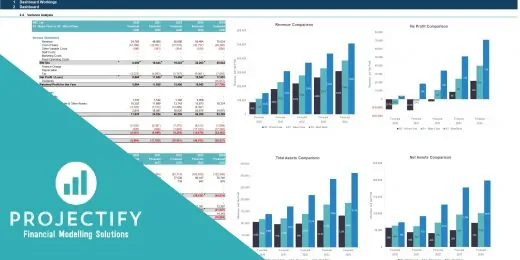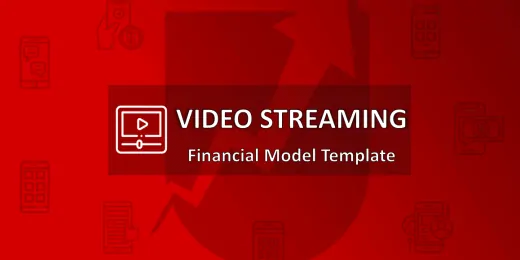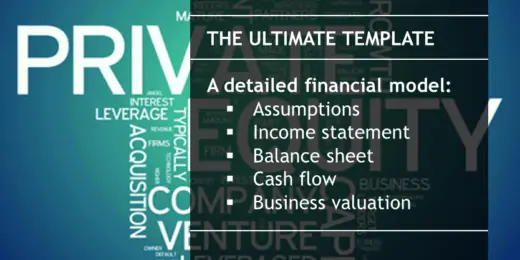Financial Modeling for Startups and Small Businesses

Ensuring to have a healthy business is to have a working financial plan that will help with managing the business to make the right strategic financial decisions. Especially for startup businesses, creating a financial plan is a critical factor for the business’ survival against countless competitors and other risks that one might encounter especially for startups that’s new to the industry.
What is Financial Modeling? Financial modeling is a tool, used to create a representation of a company’s financial status. This is commonly in the form of an Excel spreadsheet, created to show a company’s earnings and expenses and can be used to predict and measure the impact of future events or decisions. This is used by many business owners, big or small, to help them decide on many financial situations.
The best way to present the financial plan is to build a financial model for a startup that will help answer questions that you need an answer to ensure your business’ financial feasibility and profitability. This is why financial modeling skills become handy for entrepreneurs.
Importance of Financial Modeling for Startups
Creating Financial Models even for a business startup is very important to build a strong foundation regarding the financial identity of the company. It’s much important for reasons such as decision making related to mergers and acquisition, raising capital and additional funds, financial management, and others. Financial model for startup is the core element to take major business and financial decisions and the most important tools for planning and execution of business decisions for better results.
Here are some of the most important reason as to why you should prepare Financial Models for your business:
- Financial Model for Startup is created as an attractive financial representation of the company’s monetary situation. Basically, if you want to attract potential investors, you need to produce the best possible version of a financial model having excellent figures and values to show them.
- The main purpose of Financial Model for Startup is for future planning related to the company’s finances. It allows the creation of better financial decisions within the company.
- Financial Models play an important role in Capital Budgeting. It mainly helps to determine the capital structure or cost of capital, as well as to create an analysis for resource allotment and the like. For this reason, it offers a detailed review of the debt/equity system along with the returns expected by the investors.
- Another use of financial model for small businesses is to optimize the financial performance of the company. The most obvious use of financial modeling is to optimize the day to day operations of a firm. Companies use these models to determine how they can most profitably invest their resources and capital.
- For people working with investors, mergers, acquisitions, company executives, and others, financial models is of very great importance and document to prepare beforehand. The key explanation of why it is so important is that millions of dollars are on line with these big business transactions, and most of the decision-making comes down to the financial models.
- Companies extending credit in order to increase sales bear a lot of risks if not properly assessed. Hence, they need to determine first if the third-party is worth lending credit or not through a financial model analysis.
Not all startup businesses have the financing so, creating a financial model is the best tool to attract potential investors. Therefore, financial modeling for startups & small businesses is very important as well as a great factor to raise financing.
10 Elements of a Good Financial Model for Startups
For startups, the following elements are what we recommend for you to have. There are certain components that complete a startup financial model for small businesses which is done accordingly in a sequence to avoid going back and forth through the sheets.
- Sales forecast – create a sales projection over the course period (whether for short-term or long-term planning).
- Expenses Budget – create an expense budget plan as you need to have a better understanding of the cost you will expend to make the sales forecast plausible and feasible.
- Cash Flow Planning – develop a cash flow statement to track the flow of cash in and cash out of your business operations, partly basing it off your sales forecasts, balance sheet, and other assumptions.
- Income Projections – or the so-called revenue forecast for the upcoming years by using the sales forecast, expense forecast, and the cash flow projection.
- Balance Sheet Projection – deal with assets and liabilities that weren’t included in your income projection to project the net worth of your business at the end of the fiscal year, especially for startups.
- Breakeven Analysis – conduct a breakeven analysis after mapping out the whole projections, this is to assess if the business’s expenses match the sales or service volume. The analysis is conducted to measure when the business will reach the break-even point which is an important key for potential investors to refer to if the business is financially feasible and a good investment.
- Calculation of Funding Required – Preparing and showing the company’s required amount of funding is much helpful if the management seeks to present this to prospective investors or any financial lending agencies.
- IRR Calculation – Businesses use this to calculate which discount rate compares the initial cost of the capital expenditure to the present value of expected after-tax cash flows. That is why IRR is one central component of capital budgeting and corporate finance.
- Exit Scenario and Multiple – Also, we should not forget to prepare an Entry and Exit Valuation. We need to carefully calculate and present an attractive Exit Scenario and Multiple to show prospective investors and compel them to invest their money on you.
- Shareholder Structure – Lastly, we also need to show the existing Shareholder Structure, along with the percentage of equity and financing. This is very valuable data for prospective investors to assess the percentage share of the company’s equity.
Altogether, it completes a basic startup financial plan model. The process may look simple and easy, but of course, the process is more than it seems. A lot of time is needed to be set aside just to build a financial model for your startup business. Not to mention that you at least need to have an acceptable amount of industry know-how to make the financial model reliable and work as it should be. To help you with how to build a complete model, you can read it here: Building a Financial Model.
General Tips in Creating Financial Models
Financial Modeling is quite a complicated process depending on the goal you wanted to achieve, or question you want to answer. One cannot simply map out the precise steps needed, therefore we list down here our tips and suggestions on what to add on your Financial Models.
Knowing the general steps can be beneficial when you try to create a financial model for startup. So here are some general tips in Financial Models creation:
- Gather Historical Data – If the business that prepares the financial model has been in operation for some time, beginning with its past financial statements would be a wise decision. It has to be noted, however, that past patterns only give assumptions and may vary in the future. In certain situations, financial models are built for start-ups where no prior data are available.
- Forecast Scenarios and Understand Parameters – A financial model is intended to reliably predict the revenues and expenditures that could arise in the future. These numbers of revenues and expenditures are simply the product of an interaction between multiple parameters that underlie them. Consequently, if an attempt is made to forecast the numbers without knowing the parameters involved, the predictions would probably not be very accurate.
- Determine Financial Situation – A declaration of profit and loss gives away a clear representation of the expenses and revenue performance. For example, when output volume rises or decreases, not all expenditures behave in the same way. It is important to understand this situation by providing accurate data in the financial model. This will ensure the model produces accurate results when used to know the anticipated profitability at various levels of output.
- Secure Logical and Accurate Values – One must always make sure their model is rational. Therefore it is important to define and model the inter-relationships between different parameters. Further steps are required to ensure the model’s logical accuracy. It is for this reason that all defined parameters need to be given and laid down correctly.
- Result Analysis – Finally, the financial model should be constructed in such a way as not to deliver only one outcome. The truth is that the future is highly unpredictable, and the decision-makers would be better off if several options were presented.
The bottom line is that financial modeling is a very challenging task. These steps provide only a few guidelines to help you but still need to do a lot of researching to build an excellent financial model. Also, there are way more steps that need to be undertaken on the basis of the particular financial model being developed.
Startup Business Models – Examples
As you can see, you can’t just blindly build a financial model for small businesses. Financial modeling for startups & small businesses can also vary depending on what type of startup business model you are referring to. The following are startup business model examples that you can use as a reference in deciding what kind of startup business you want to start in the future.
- Subscription-based business model – the customers will need to pay a subscription fee to gain access to the product or services offered. It used to be a business model for magazines and newspapers, but nowadays, it is used by many businesses and websites, providing services or products that require the customer to pay in a subscription basis.
- Product-based business model – every store or shop selling physical products, such as clothing, jewelry, cars, etc. are all businesses that apply this kind of business model. It is considered as the most commonly used business model for startups since it is very straightforward and an easy choice to start a business with.
- Service-based business models – this business model works the same as the Product-based business model except, instead of selling physical products, offering services that consumers need, is the main agenda. The best examples that use this kind of business model are hotels, restaurants, consulting firms, etc.
- Retailing – considered one of the most common business models that entrepreneurs often start with. It is a business model where a retailer purchases the products from a distributor or wholesaler and sometimes directly from the manufacturers, then proceed to sell the said products to the market.
- Manufacturing – a common business model where it focuses on taking raw materials and produce products out of it. This can also apply to companies that assemble finished products from premade parts. The products are then distributed to either the wholesalers or retailers and sometimes, even directly selling to the masses.
- Distribution – goes hand in hand with retailers and manufacturers. A startup business model that plays a role in-between the provider or manufacturer of products and the masses or to a retailer which will then distribute to the mass consumers.
- Niche business – a startup business model that is not completely that rare but not that common either. The main focus is on the needs of a market niche and services it in a way with products and services that a larger business can’t. An example of this would be special boutiques, agencies, etc.
The list above is just the most basic startup business models that one can proceed on. There are, of course, many more that you can choose from. You can check out a more thorough list of business models here: Business Model Examples.
Download Financial Plan Template for Startup Businesses
To ensure that you are prepared for the unknown as well as manage your finances, the need to have a working financial plan is very important. Just by simply having a financial plan for a startup business will make a huge difference for it can help with the management of the financials as well as be able to make the right strategic financial decisions and avoid certain risks that will affect the business in the future. This is why creating a financial plan is a critical factor for a startup business’s survival against countless competitors that already existed and other risks that one might encounter especially for startups that are new to the industry. Hence, it is very important to create a financial plan for startups.
It’s a good thing that it is possible to build a financial model for a startup business without having to spend a lot of time and money. One does not need to be a professional either to be able to model a Startup Financial plan model. To create a startup financial model for your business, you do not need to be a finance expert for what you need is the right set of tools, such as a financial plan template for a startup business to simply get started. By utilizing these available templates for download, you can acquire a template to use as a starting point for your financial model.
Downloading a financial plan template for a startup business is very convenient as well as provides a nifty tool to help the financing for a startup business. So, if you’re interested and in need of a financial plan template for a startup business, you can take a look here at eFinancialModels for more financial model templates for startups, as you freely choose from which industry your preferred startup business model fits.
Rest assured, our financial model templates ensured with the best quality from different financial modeling experts and are ready-made to be used by any kind of users such as executives, bankers, agents, entrepreneurs, etc., from different countries such as the USA, UK, Canada, Australia, Japan, Germany, France, and many more countries all over the world who are looking for ready-made financial plan templates to support them in completing their financial modeling and analysis tasks.




































































































